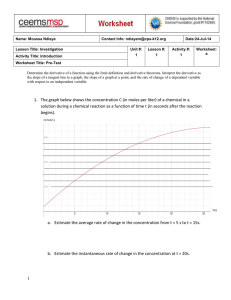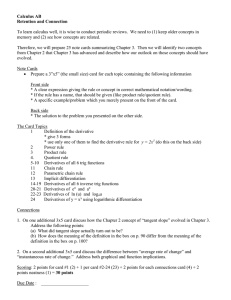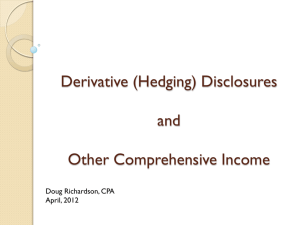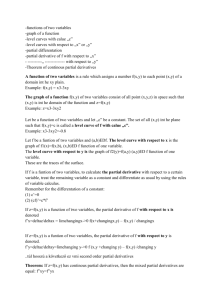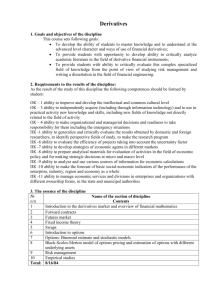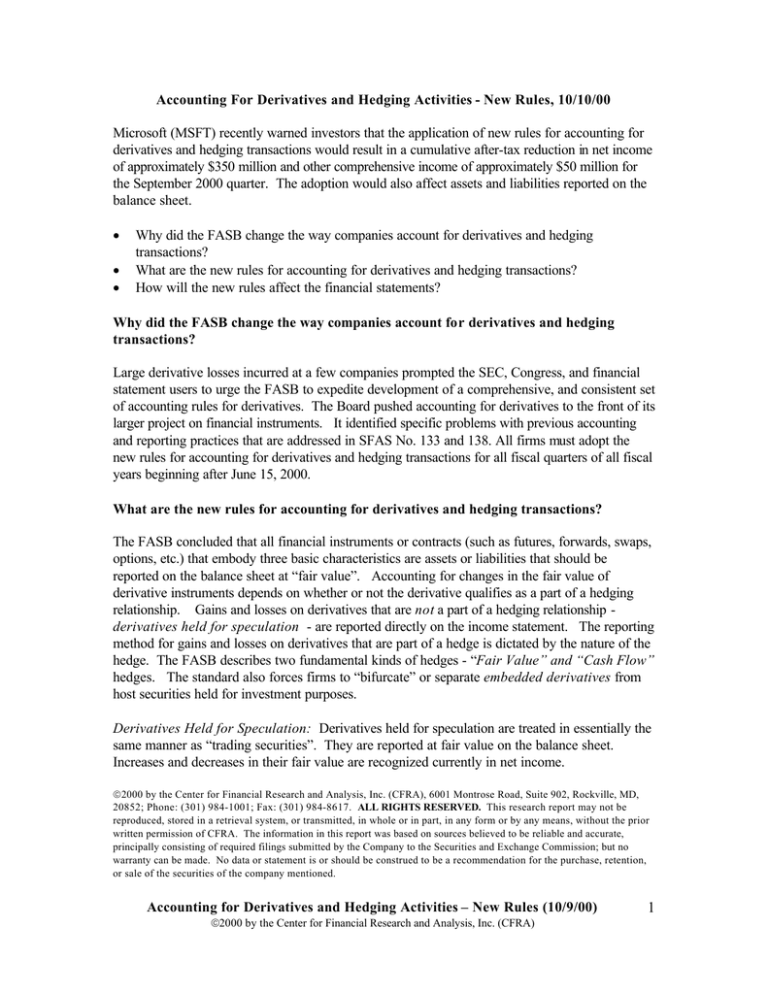
Accounting For Derivatives and Hedging Activities - New Rules, 10/10/00
Microsoft (MSFT) recently warned investors that the application of new rules for accounting for
derivatives and hedging transactions would result in a cumulative after-tax reduction in net income
of approximately $350 million and other comprehensive income of approximately $50 million for
the September 2000 quarter. The adoption would also affect assets and liabilities reported on the
balance sheet.
•
•
•
Why did the FASB change the way companies account for derivatives and hedging
transactions?
What are the new rules for accounting for derivatives and hedging transactions?
How will the new rules affect the financial statements?
Why did the FASB change the way companies account for derivatives and hedging
transactions?
Large derivative losses incurred at a few companies prompted the SEC, Congress, and financial
statement users to urge the FASB to expedite development of a comprehensive, and consistent set
of accounting rules for derivatives. The Board pushed accounting for derivatives to the front of its
larger project on financial instruments. It identified specific problems with previous accounting
and reporting practices that are addressed in SFAS No. 133 and 138. All firms must adopt the
new rules for accounting for derivatives and hedging transactions for all fiscal quarters of all fiscal
years beginning after June 15, 2000.
What are the new rules for accounting for derivatives and hedging transactions?
The FASB concluded that all financial instruments or contracts (such as futures, forwards, swaps,
options, etc.) that embody three basic characteristics are assets or liabilities that should be
reported on the balance sheet at “fair value”. Accounting for changes in the fair value of
derivative instruments depends on whether or not the derivative qualifies as a part of a hedging
relationship. Gains and losses on derivatives that are not a part of a hedging relationship derivatives held for speculation - are reported directly on the income statement. The reporting
method for gains and losses on derivatives that are part of a hedge is dictated by the nature of the
hedge. The FASB describes two fundamental kinds of hedges - “Fair Value” and “Cash Flow”
hedges. The standard also forces firms to “bifurcate” or separate embedded derivatives from
host securities held for investment purposes.
Derivatives Held for Speculation: Derivatives held for speculation are treated in essentially the
same manner as “trading securities”. They are reported at fair value on the balance sheet.
Increases and decreases in their fair value are recognized currently in net income.
2000 by the Center for Financial Research and Analysis, Inc. (CFRA), 6001 Montrose Road, Suite 902, Rockville, MD,
20852; Phone: (301) 984-1001; Fax: (301) 984-8617. ALL RIGHTS RESERVED. This research report may not be
reproduced, stored in a retrieval system, or transmitted, in whole or in part, in any form or by any means, without the prior
written permission of CFRA. The information in this report was based on sources believed to be reliable and accurate,
principally consisting of required filings submitted by the Company to the Securities and Exchange Commission; but no
warranty can be made. No data or statement is or should be construed to be a recommendation for the purchase, retention,
or sale of the securities of the company mentioned.
Accounting for Derivatives and Hedging Activities – New Rules (10/9/00)
2000 by the Center for Financial Research and Analysis, Inc. (CFRA)
1
Fair Value Hedges: A fair value hedge offsets the firm’s exposure to changes in the fair value
of another asset or liability. An interest rate swap is a good example of this kind of hedge. The
derivative instrument is reported at fair value on the balance sheet. The FASB also requires firms
to value the hedged item at “fair value” even when historical cost would otherwise be used.
Increases and decreases in both the fair value of the derivative instrument and the fair value of
the hedged item are reported in net income. Gains and losses on the derivative are, therefore,
offset by the opposite change in the fair value of the hedged item.
Cash Flow Hedges: A cash flow hedge reduces a firm’s exposure to variability in expected
future cash flows related to an existing asset or liability or anticipated future transaction. For
example, a futures or forward contract giving the firm the right to buy a commodity at a preset
price protects the firm from possible price increases. The contract is a part of a cash flow hedge,
as opposed to a speculative derivative, if the firm anticipates making the future purchase.
Derivative instruments providing effective cash flow hedges are measured and reported at fair
value on the balance sheet. Gains and losses in fair value are recorded in equity as a part of other
comprehensive income but are reclassified into earnings when the hedged forecasted transaction
affects earnings. If a firm enters into a futures contract to buy a commodity, increases or
decreases in fair value of the contract are reported in equity as part of comprehensive income
until the commodity is sold or used up and becomes an expense. At that point the gain or loss
accumulated in equity is reclassified into net income.
Foreign Currency Hedges: The FASB devotes special attention to foreign currency hedges. In
general, however, these hedges are categorized as either fair value or cash flow hedges. The
accounting is essentially the same as for hedges involving other kinds of assets and liabilities.
Embedded Derivatives: “Hybrid securities”, such as convertible bonds, are a combination of a
traditional financial debt security (the host contract) and a conversion feature (the embedded
derivative), which is essentially a stock option. In most cases, SFAS 133 requires investors to
separate the embedded derivative from the host security (bifurcation). Each is then accounted
for according to GAAP. This rule applies only to investments in hybrid securities. The FASB is
dealing with accounting for issued hybrid securities in another project.
In our complex financial environment identification and classification of derivatives and types of
hedges is far from simple. Embedded derivatives pose numerous conceptual and practical
problems. The FASB established the Derivatives Implementation Group to identify and resolve
significant questions. To date the task force has published responses to 114 different issues
presented by firms struggling to apply this new set of rules.
How do the new rules affect the financial statements?
The new rules require recognition of all derivative instruments as either assets or liabilities.
Derivative instruments always reported at “fair value” on the balance sheet.
Accounting for Derivatives and Hedging Activities – New Rules (10/9/00)
2000 by the Center for Financial Research and Analysis, Inc. (CFRA)
2
Increases and decreases in the fair value of derivative instruments will be appear either on the
income statement or as a component of comprehensive income. The rules differentiate between
speculators and those who use derivatives for risk management. Firms that hold derivatives for
speculation purposes report all gains and losses immediately on the income statement.
Derivatives that are part of hedges are less likely to affect net income either because of offsetting
changes in the value of the hedged item or because the rules allow the firms using them to report
gains and losses as a part of comprehensive income. (See Table 1)
Table 1: Accounting for Derivatives and Hedging Transactions on Financial Statements
Derivative
Purpose
Reported on
Balance Sheet
Speculation
Derivative: Asset or
Liability at FV
Increase or decrease in
Fair Value of derivative
Derivative: Asset or
Liability at FV
Increase or decrease in
FV of derivative
Fair Value
Hedge
Reported in
Net Income
Reported in
Comprehensive
Income
NA
NA
Hedged Item: Asset or
Liability at FV
Cash Flow
Hedge
Derivative: Asset or
Liability at FV
Offsetting increase or
decrease in FV of
Hedged Item
Increase or decrease in
FV of derivative, which
is reclassified into net
income when hedged
forecasted transaction
affects net income.
Initial application of the FASB statement begins with the first fiscal quarter of the first fiscal year
after June 15, 2000. Firms with fiscal years ending on June 30th, such as MSFT, began applying
the new rules in the September 2000 quarter. Upon initial application, the firm has to restate all
freestanding derivative instruments to fair value and to recognize any offsetting gains and losses
on hedged assets and liabilities. The cumulative effect of the change in accounting principle is
reported in net income or other comprehensive income, as appropriate. Restatement for MSFT
resulted in a $350 million charge to net income and a $50 million charge to comprehensive income.
The restatement could, of course, result in increased net and/or comprehensive income.
Accounting for Derivatives and Hedging Activities – New Rules (10/9/00)
2000 by the Center for Financial Research and Analysis, Inc. (CFRA)
3




